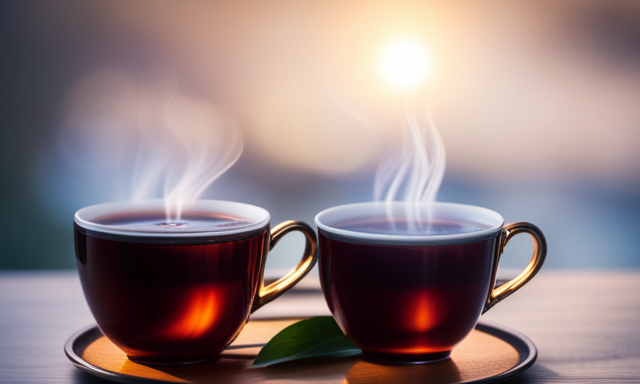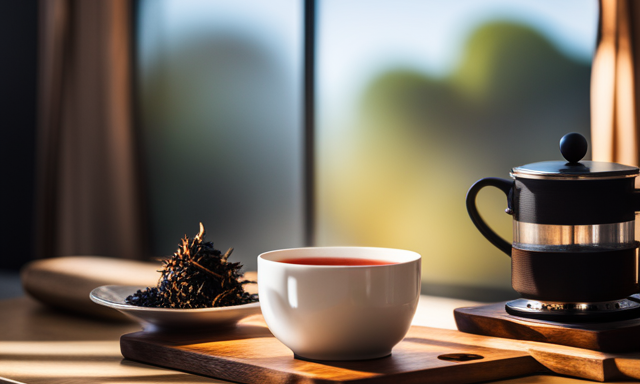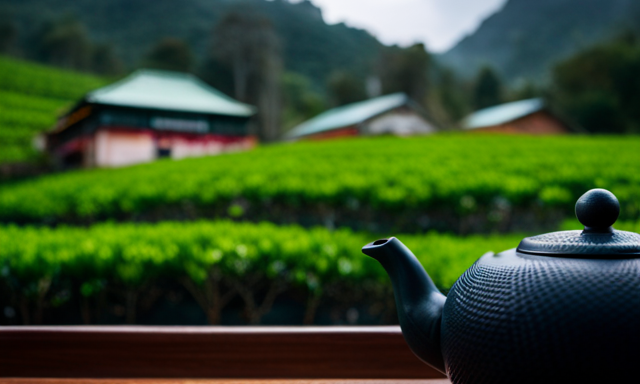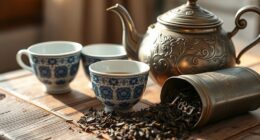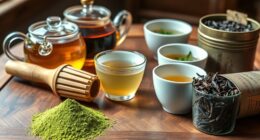Imagine sitting down to enjoy a warm, soothing cup of tea. The steam rises from the mug, creating a comforting aroma that fills the air. But which tea should you choose? Oolong or kombucha? Both have gained popularity in recent years for their potential health benefits and unique flavors.
In this article, I will explore the characteristics of oolong and kombucha teas, their brewing techniques, and their respective health benefits. By examining the evidence and analyzing the flavors, we can determine which one is better suited to our individual preferences and needs.
So, grab your favorite mug and join me on this journey to discover the wonders of oolong and kombucha teas.
Key Takeaways
- Oolong tea has a delicate, floral aroma, while kombucha has a tangy, slightly sour aroma.
- Oolong tea has a smooth, slightly sweet taste, while kombucha has a unique, fizzy, and slightly acidic taste.
- Oolong tea is partially fermented, while kombucha is fermented with a SCOBY.
- Oolong tea falls between black and green tea in terms of taste profile, with a range of flavors, while kombucha has a mix of fruity, vinegary, and yeasty flavors.
What is Oolong Tea?
Oolong tea is a delicious blend of black and green teas, offering a unique and invigorating flavor. It is known for its distinct taste and aroma, making it a popular choice among tea enthusiasts.
The brewing techniques for oolong tea vary depending on personal preference, but generally involve steeping the leaves in hot water for a specific amount of time. This allows the flavors to develop and create a satisfying cup of tea.
Apart from its delightful taste, oolong tea also offers numerous health benefits. It contains antioxidants that can help reduce the risk of chronic diseases, support heart health, and promote weight loss. Additionally, oolong tea has been linked to improved digestion and a boost in metabolism.
Now, let’s move on to explore what kombucha is all about.
What is Kombucha?
If you’re curious about fermented beverages, you might be interested in learning about Kombucha. It’s a fizzy drink made by fermenting sweetened tea with a culture of bacteria and yeast known as a SCOBY. Picture a living ecosystem thriving within a jar, transforming a simple blend into a tangy elixir that tickles your taste buds with each sip.
Kombucha undergoes a fermentation process that converts the sugar in the tea into alcohol and then into acetic acid, giving it its unique tangy flavor. This fermentation process also produces trace amounts of alcohol, caffeine, and organic acids, contributing to its overall composition.
Kombucha is known for its potential probiotic benefits, as the fermentation process creates a range of beneficial bacteria and yeast that may support gut health. People enjoy Kombucha for its refreshing taste and potential health benefits, although more research is needed to fully understand its effects on the body.
If you’re interested in exploring the world of fermented beverages, Kombucha is definitely worth a try.
Now, let’s transition into the subsequent section about the health benefits of oolong tea.
Health Benefits of Oolong Tea
With its rich history and complex flavor profile, oolong tea offers a myriad of potential health benefits. Oolong tea, a traditional Chinese tea, is known for its unique semi-fermented processing method, which gives it a distinctive taste and aroma.
This tea is packed with antioxidants, which can help reduce the risk of chronic diseases like heart disease and certain types of cancer. Additionally, oolong tea has been shown to improve brain function and promote weight loss by boosting metabolism.
There are various varieties of oolong tea available, each with its own unique flavor and health benefits. These include Tie Guan Yin, Da Hong Pao, and Bai Hao.
Transitioning into the subsequent section about the health benefits of kombucha, it’s important to consider the differences between these two beverages.
Health Benefits of Kombucha
Transitioning to the health benefits of kombucha, it’s fascinating to explore the myriad of ways this fermented beverage can positively impact our well-being.
Kombucha is made through a two-step brewing and fermentation process. During the brewing process, a sweetened tea is combined with a culture of bacteria and yeast called a SCOBY (Symbiotic Culture Of Bacteria and Yeast). This mixture is left to ferment for a period of time, usually around one to two weeks.
The fermentation process results in the production of various beneficial compounds such as organic acids, probiotics, and antioxidants. These components have been linked to potential health benefits, including improved digestion, immune system support, and detoxification. Additionally, some studies suggest that kombucha may have antimicrobial and anti-inflammatory properties.
With these impressive health benefits in mind, let’s now delve into the brewing techniques for oolong tea.
Brewing Techniques for Oolong Tea
When it comes to brewing oolong tea, two key factors to consider are water temperature and steeping time. The water temperature should be around 180-200°F, as this allows the leaves to release their flavors without becoming too bitter.
Steeping time can vary depending on personal preference, but generally, 3-5 minutes is recommended for a balanced brew.
As for teaware and infusion methods, using a gaiwan or a clay teapot is ideal for oolong tea, as they allow for better heat retention and extraction of flavors.
The infusion method can be either gongfu style, where multiple short steepings are done, or a longer steeping in a larger teapot.
By paying attention to these brewing techniques, one can enjoy a flavorful and well-balanced cup of oolong tea.
Water Temperature and Steeping Time
Although it’s essential to consider the water temperature and steeping time, oolong tea and kombucha both offer distinct flavors and health benefits. When brewing oolong tea, the water temperature plays a crucial role in extracting the flavors properly. Generally, a water temperature between 190-200°F (88-93°C) works well for most oolong teas. Steeping time also varies depending on the desired strength, but a common range is 3-5 minutes.
Here are some key points to keep in mind:
- Use water that’s below boiling to prevent scorching the delicate leaves.
- Experiment with different steeping times to find your preferred taste.
- Adjust the steeping time based on the specific oolong tea type.
- Longer steeping times generally yield a stronger, bolder flavor.
- Be mindful not to oversteep, as it can result in a bitter taste.
Considering the importance of water temperature and steeping techniques, let’s now delve into teaware and infusion methods to further enhance your oolong tea experience.
Teaware and Infusion Methods
Now that we’ve discussed the importance of water temperature and steeping time, let’s move on to the next factor that can influence the taste of oolong and kombucha tea: teaware and infusion methods.
Different tea varieties require different teaware to bring out their best flavors. For oolong tea, a traditional teapot made of clay or porcelain is often recommended, as it allows the leaves to expand and release their flavors fully. On the other hand, kombucha tea is usually brewed in glass jars or ceramic containers to facilitate fermentation.
In addition to teaware, infusion methods also play a crucial role in determining the taste of the final brew. Steeping oolong tea for a shorter time can result in a lighter flavor, while a longer steeping time can yield a stronger, more robust taste. Similarly, the infusion time for kombucha can affect its acidity and carbonation levels.
Moving forward, let’s explore the brewing techniques for kombucha, which’ll further enhance our understanding of these two teas.
Brewing Techniques for Kombucha
To create the perfect batch of kombucha, mastering the art of brewing techniques is essential. Kombucha fermentation involves a symbiotic culture of bacteria and yeast (SCOBY) that converts tea and sugar into a fizzy, tangy, and slightly sweet beverage. The type of tea used plays a significant role in the flavor profile of the final product. While black tea is commonly used, oolong tea can also be a great choice. Oolong tea undergoes partial oxidation during processing, giving it a unique flavor and aroma. This oxidation process enhances the complexity of the kombucha’s taste, resulting in a richer and more nuanced beverage. By experimenting with different brewing techniques and tea varieties, you can discover the perfect combination to suit your taste preferences. Moving on to the subsequent section about flavor comparison, let’s explore how oolong compares to other teas in terms of taste.
Flavor Comparison
When comparing the aroma and taste profiles of Oolong tea and Kombucha, it’s important to consider their distinct characteristics.
Oolong tea typically has a delicate and floral aroma, with a smooth and slightly sweet taste.
On the other hand, Kombucha has a tangy and slightly sour aroma, with a unique, fizzy, and slightly acidic taste.
These flavor profiles are based on the brewing techniques and ingredients used in each beverage, resulting in distinct sensory experiences for tea lovers.
Aroma and Taste Profile of Oolong Tea
If you’re looking for a tea with a nuanced aroma and a complex flavor profile, oolong tea might be the better choice for you. Oolong tea is known for its unique brewing process, which involves partially fermenting the leaves before they’re dried. This process gives oolong tea a distinct taste that falls between black and green tea.
There are numerous oolong tea varieties to choose from, each with its own flavor characteristics. Some oolong teas have a floral aroma, while others have a more earthy or fruity scent. When brewed properly, oolong tea has a smooth and balanced flavor that can range from sweet and creamy to slightly bitter and toasty. With its diverse range of flavors and aromas, oolong tea offers a delightful experience for tea enthusiasts.
Moving on to the aroma and taste profile of kombucha…
Aroma and Taste Profile of Kombucha
With its effervescent tang and vibrant flavor, kombucha dances on the palate like a fizzy symphony of fermentation. The aroma of kombucha is often described as a mix of fruity, vinegary, and yeasty notes, which can be quite strong and distinctive.
When it comes to taste, kombucha offers a refreshing and slightly tart sensation, with a hint of sweetness. The brewing process of kombucha involves fermenting sweetened tea with a symbiotic culture of bacteria and yeast (SCOBY), resulting in the characteristic flavors and carbonation.
On the other hand, oolong tea boasts a more nuanced aroma and taste profile, with floral, fruity, and toasty undertones. The brewing process for oolong tea is much simpler, involving the oxidation and rolling of tea leaves.
So, while kombucha offers a unique and lively experience, oolong tea provides a more delicate and refined flavor.
Now, let’s explore which one is right for you?
Which One is Right for You?
Choosing between oolong and kombucha tea can be a delightful journey to finding the perfect option for you. Both oolong tea and kombucha have their own unique characteristics and benefits.
Oolong tea offers a rich and complex flavor profile, ranging from fruity to floral, with a slightly sweet aftertaste. It’s known for its potential health benefits, such as aiding in weight management and promoting heart health.
On the other hand, kombucha is a fermented tea that has a tangy and slightly fizzy taste, often described as both sweet and sour. It’s popular among tea enthusiasts and health-conscious individuals due to its probiotic properties and potential benefits for gut health.
Ultimately, the choice between oolong and kombucha tea depends on your personal preferences and health goals.
In the next section, we’ll explore the conclusion and final thoughts on these two wonderful tea options.
Conclusion and Final Thoughts
To make a final decision, consider that oolong tea has been enjoyed for centuries, while kombucha has gained popularity in recent years, showing the enduring appeal of both options.
When deciding between oolong and kombucha tea, it’s important to weigh the pros and cons of each. Here are four factors to consider:
-
Taste: Oolong tea has a smooth, floral flavor, while kombucha tea has a tangy, effervescent taste.
-
Health benefits: Oolong tea is rich in antioxidants and may aid in weight loss, while kombucha tea contains probiotics that can support gut health.
-
Caffeine levels: Oolong tea contains moderate levels of caffeine, providing a gentle energy boost, while kombucha tea typically has lower caffeine content.
-
Brewing process: Oolong tea requires steeping leaves in hot water, while kombucha is made through a fermentation process using a SCOBY.
Ultimately, the choice between oolong and kombucha tea depends on personal preference and health goals. Both options offer unique flavors and potential benefits, so it’s worth trying both to see which one suits you best.
Frequently Asked Questions
Can oolong tea and kombucha be combined to create a unique flavor and health benefits?
Combining oolong tea and kombucha can result in a unique flavor profile and potential health benefits. The combination may offer a balance of antioxidants, probiotics, and polyphenols, promoting overall well-being. However, further research is needed to understand the specific advantages.
What is the caffeine content in oolong tea and kombucha?
The caffeine content in oolong tea is approximately 37 mg per 8 oz serving, while kombucha typically contains less than 20 mg per 8 oz serving. Both beverages offer various health benefits, including antioxidant properties and potential support for digestion and immune function.
Are there any potential side effects or risks associated with consuming oolong tea or kombucha?
There are potential side effects of consuming oolong tea or kombucha, such as digestive issues and allergic reactions. However, both have health benefits, including antioxidant content and gut health benefits.
Can oolong tea or kombucha help with weight loss?
Oolong tea and kombucha both have potential weight loss benefits. They may help boost metabolism and aid in fat burning. However, more research is needed to determine their exact effects and how they compare to each other.
Are there any specific recommendations on the best time of day to consume oolong tea or kombucha for maximum benefits?
The best time to consume oolong tea for maximum benefits is in the morning, as it can boost metabolism and aid in weight loss. Similarly, consuming kombucha in the morning provides probiotics and antioxidants.
Conclusion
After exploring the health benefits and brewing techniques of both oolong tea and kombucha, it’s clear that both have their own unique qualities. Oolong tea offers a soothing taste and potential benefits such as weight management and improved heart health.
Kombucha, on the other hand, provides probiotics and potential immune-boosting effects. Ultimately, the choice between the two comes down to personal preference and health goals. So, whether you prefer the smoothness of oolong or the tangy fizz of kombucha, both can be enjoyed as part of a healthy lifestyle.

